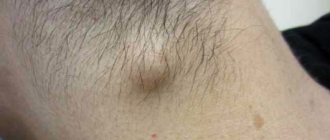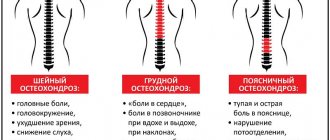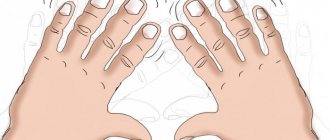Causes of headaches behind the ears
A headache in the ear area is a symptom of various pathologies that can cause significant harm to health. Doctors advise paying attention to the first symptoms, as diseases can progress. Painful sensations behind the ears can be accompanied by fever, hearing loss and other complaints - they must be taken into account during diagnosis.
Diseases of the hearing organ
The main reason why a headache behind the ear on the left or right is due to diseases of the hearing organ. Discomfort can be caused by inflammatory processes or damage in any of its parts. The hearing organ is divided into the outer, middle and inner ear. The outer part is represented by the auricle, ear canal and eardrum. The main function of the middle ear is to equalize pressure in the outer and inner sections. The inner ear has the most complex structure and is called the labyrinth. It is he who recognizes sound vibrations and transmits them to the cerebral cortex.
Chronic or throbbing pain in the head behind the ear may be the first sign of the following diseases:
- Otitis is an inflammation of the outer, middle or inner ear. The disease is accompanied by acute pain and discomfort. An advanced process can be complicated by purulent inflammation, in which case discharge from the ear canal appears.
- Labyrinthitis is a dangerous disease, inflammation of the labyrinth of the inner ear. The process is often one-sided, manifesting itself on the left or right side. Complaints include not only headaches, but also nausea and loss of coordination. The labyrinth is responsible not only for the perception of sounds, but also for balance.
- Meniere's disease is a pathology of non-infectious origin. Its main symptom is an increase in the volume of endolymph, the fluid in the inner ear. It is manifested by chronic unilateral pain behind the ear, nausea, and decreased hearing acuity.
- Mastoiditis is an inflammatory process that affects the process of the temporal bone. It can be caused by injury, viral or bacterial infection. It is accompanied by elevated temperature, a sharp deterioration in health, and purulent discharge from the auditory canals. The disease is more often diagnosed in children than in adults.
- Fungal diseases (otomycosis) - cause inflammatory reactions, itching and irritation. The infection most often affects the external parts of the hearing organ. In the initial stages, the fungus is not dangerous, but without treatment it can become complicated by purulent processes.
Head pain in the ear area is a dangerous phenomenon, since it may indicate various diseases of the hearing organ. Pathological processes without timely treatment spread to the internal parts. Air deficiency and the presence of endolymph provide a favorable environment for the development of bacterial infection. Its development is dangerous due to purulent inflammation, which can cause damage to the membranes of the brain and deterioration of hearing until it is completely lost.
Infectious diseases
Seasonal colds, acute respiratory viral infections and influenza are common diseases that affect adults and children. They are caused by a viral infection and are transmitted through airborne droplets and household routes. They can be recognized by their characteristic features:
- headaches behind the ears, as well as in the forehead and back of the head;
- increase in body temperature to 37 degrees or more;
- nasal congestion, swelling of the mucous membranes;
- cough, sore throat, redness and soreness;
- general weakness, drowsiness, decreased performance.
With viral diseases, the temperature rises already in the first days after the infection becomes active. This sign, combined with pain in the head near the ear, indicates the need to stay in bed, drink plenty of fluids and take supportive medications. However, if your health suddenly deteriorates, self-medication will be harmful. Even a common cold can be complicated by pneumonia or spread to the membranes of the brain if the immune system is weakened and cannot cope with the infection.
Other reasons
If your head hurts behind your ears, this may indicate various disorders. This symptom accompanies various infectious and non-communicable diseases that occur in acute or chronic forms. As a result of the diagnosis, pathologies may be detected that require urgent treatment.
- Migraine is a chronic disease that manifests itself as a one-sided headache, but can affect the entire surface of the head. Its exacerbation can be caused by hormonal changes, changes in atmospheric pressure, stress and other reasons. Migraine is often diagnosed in middle-aged women.
- Lymphadenitis is inflammation of the lymph nodes. In the ear area there are auricular, occipital and cervical lymph nodes. They can become inflamed due to previous infectious diseases, as well as with pathologies of the immune system. Superficial nodes are felt under the skin in the form of round, painful, dense formations. In an acute process, redness of the skin over the affected area and an increase in general body temperature may be observed.
- Shingles is a fungal disease that is transmitted by contact. Its pathogen can also be found on towels, bedding and other household items that come into contact with the skin. It causes pain, inflammation, severe itching, redness and peeling of the skin in the neck, back of the head and ears. The disease causes acute headaches, lumbago in the muscles and a general deterioration in well-being.
- Neuralgia is pain associated with inflammation or damage to the nerves. Headaches behind the ear are associated with the trigeminal nerve, which carries branches to the skin of the face and scalp. The causes of neuritis are hypothermia, previous viral diseases, injuries to the cervical spine and other factors.
- Arthritis or arthrosis of the temporomandibular joint is a pathology that causes unilateral acute pain behind the ear. It intensifies during chewing, talking and any jaw movements. Diseases can be caused by injuries, dental problems, and infectious agents.
- Neoplasms inside the auricle are a surgical pathology. During diagnosis, boils, tumors and other formations may be detected that cause pain and itching and cause hearing impairment. Their timely removal will restore normal health and prevent complications.
- Dental diseases are one of the common causes of ear pain. Caries, incorrect position of teeth and other pathologies can cause destruction of surrounding tissues and acute pain.
A headache that affects the area behind the ears can occur even in the absence of serious problems. It occurs when you are very tired, after intense physical activity, or due to stress. In some cases, symptoms disappear after proper rest, restoration of sleep patterns, and also as a result of proper nutrition. However, if the headache occurs frequently, it is important to seek medical help.
The infection causes severe pain
Another reason that provokes the appearance of pain behind the ear is the inflammatory process. Otitis media can be external, middle or internal. External inflammation includes inflammation of the skin of the ear concha and the external auditory canal. The disease is accompanied by pain, and the occurrence of a purulent process makes the pain throbbing. Additional symptoms include: pain in the ear itself, noise, and congestion. However, all of the above symptoms may not occur. Otitis is diagnosed if there is a feeling of pressure, fullness, which intensifies with tilting of the head. Insufficient and incorrect treatment are the causes of chronic otitis media.
In addition, advanced disease is aggravated by intoxication, elevated body temperature, and discharge of pus from the ear. Pain on the left side may indicate an infection of various etiologies. For example, sore throat, sinusitis, colds. Sensations arise gradually, depending on the degree of the disease. The development of the disease increases symptoms, especially when lying down. Often the appearance of infectious diseases is accompanied by inflammation of the lymph nodes and their swelling. This disease is called lymphadenitis. It can also cause pain behind the ear, as well as in the ear, jaw, and neck. Firm, painful, enlarged lymph nodes behind the ears can be felt when pressed with fingers.
Inflammation of the nodes may occur due to hypothermia.
Advanced inflammation of the lymph nodes can provoke lymphoma.
Diagnostic methods
For headaches that affect the ear area, it is important to undergo a timely examination and determine the cause of the alarming symptoms. At the initial examination, only visible disorders are determined, including inflammatory processes, fever and other signs. However, to get a complete picture, additional examinations will be needed:
- clinical and biochemical blood tests - these data will indicate infectious processes, pathologies of the hematopoietic system, as well as disruption of the functioning of internal organs;
- bacterial culture if purulent inflammation is suspected - will allow you to identify the pathogen and select an antibiotic to which the bacteria are sensitive;
- Dopplerography - ultrasound diagnostics of blood flow in the vessels of the neck and head, prescribed to detect areas of ischemia;
- MRI or CT scan of the head – often used when tumors in the brain are suspected;
- consultations with specialized specialists – dentist, otolaryngologist, neurologist.
The Clinical Brain Institute has precise, high-quality modern equipment, which makes it easy to make the correct diagnosis in a short time. Here you can take blood tests and other biological fluids, and undergo an examination of the brain and cervical spine. Qualified specialists will help you decipher test data and identify any pathologies in the early stages.
Features of pain syndrome
Many diseases of the head, neck, blood vessels, muscles and ligaments of the spine are characterized by the appearance of discomfort in the parotid area.
Inflammatory processes
In case of inflammation of the ear itself (otitis externa), mild pain is accompanied by redness of the skin of the auricle and external auditory canal, discomfort when chewing and pressure on this area. The pain may become more severe when the concha is retracted during the formation and maturation of a boil in the external passage, narrowing the lumen of the canal. With otitis media, the pain syndrome is severe and has a shooting character. Patients, and more often these are children, cannot sleep, complain of severe pain in the left or right side of the head, radiating to the ear, discharge from the ear canal of various types from simple serous to purulent. This condition requires emergency medical attention.
A severe complication and the cause of severe pain reactions behind the right or left ear is mastoiditis (inflammation of the mastoid process). The pathology is accompanied by suppuration from the ear canal, sharp pain on the right or left behind the ear, especially when tapping on the process, swelling of soft tissues, redness of the skin in this area, hyperthermia (increase in temperature to 39-40 degrees), deterioration in the patient’s well-being, and insomnia. Adult patients complain that the bone behind the ear “hurts.” The disease requires emergency assistance from an ENT doctor and massive antibacterial therapy. Mastoiditis in the worst cases of its development will lead to paralysis of the facial nerve, breakthrough of pus through the molten bone plate into the soft tissue behind the ear with the formation of an abscess or into the posterior cranial fossa involving the meninges, sepsis.
Treatment for headaches behind the ear
The course of treatment includes various techniques that will eliminate the cause of the headache and all manifestations of the disease. A regimen can only be selected after examination and a final diagnosis; taking medications at home is not recommended. The following treatments may be needed:
- symptomatic drug therapy - includes painkillers and anti-inflammatory drugs, vitamins, remedies against cold and flu symptoms;
- antibacterial therapy - antibiotics are prescribed for bacterial diseases, as well as to prevent complications of viral infections;
- dental treatment – necessary for caries, diseases of teeth and gums;
- surgical intervention is prescribed to remove tumors in the ear canals, as well as when conservative treatment of mastoiditis is insufficiently effective.
At the Clinical Brain Institute, doctors will select the most effective treatment regimen. In most cases, taking medications as scheduled is sufficient, but additional procedures or surgery may also be required. The patient should listen to the opinion of specialists with many years of experience and strictly follow all recommendations.
Neurological diseases
Quite often, pain behind the ear can be caused by inflammatory-dystrophic changes in the cervical spine - cervical osteochondrosis. In this case, thinning of the intervertebral disc and pinching of soft tissues between the vertebral bodies are observed.
Pain behind the ear with osteochondrosis may be accompanied by a feeling of muscle stiffness and a strong crunch in the neck. Clinical signs of cervical osteochondrosis are very often mistaken for symptoms of a number of other diseases.
For diagnostic purposes, X-rays and computed tomography of the cervical spine are performed. Treatment is prescribed by a neurologist.
The bone behind the ear can also become sore with trigeminal neuralgia. In this case, severe excruciating pain affects only one side of the face and neck. In this case, the patient is prescribed anticonvulsants, as well as B vitamins.
Prevention methods
Doctors have a number of recommendations that will help prevent headaches behind the ears. They are easy to follow at home:
- observe a regime of rest and physical activity, regularly carry out moderate exercise;
- pay attention to proper brushing of teeth and oral hygiene;
- observe bed rest in case of viral diseases, avoid contact with other people;
- carry out ear hygiene, while cleaning the ears carefully so as not to damage the eardrum;
- avoid hypothermia in the neck and head;
- Seek medical help promptly if headaches occur regularly or occur with high intensity.
The Clinical Brain Institute specializes in the diagnosis and treatment of diseases that manifest themselves as headaches in the ear area. Here you can undergo a full examination and get advice from specialists of a narrow and broad profile. For long-term treatment, a course of procedures and round-the-clock supervision by doctors, it is possible to stay in a hospital. During outpatient treatment, it is important to follow all recommendations and promptly contact for re-examination.
Clinical Brain Institute Rating: 4/5 — 9 votes
Share article on social networks
Increase in pressure
A sharp change in intracranial pressure is almost always accompanied by pain on the left side of the head and ear. Ear ringing, hearing loss, and pressure on the eyes appear. Changes in ICP cause swelling of the face, eyelids, nausea, and vomiting. ICP necessarily requires treatment to bring it to a normal state. Horse racing can reduce mental abilities, disrupt the nervous state, and lead to unfortunate consequences. Sharp, burning, increasing pain sensations on the face and head are characteristic of a stroke. Pain radiating to the back of the head, numbness of the limbs, impaired speech skills, distortion of the facial muscles are obvious signs of this. Fainting, loss of coordination, nausea, along with the listed symptoms, indicate a stroke and require emergency medical attention and high-quality treatment. Important: today, stroke attacks in young people are not uncommon. Therefore, recurring headaches should not be neglected at any age. This can lead to dire consequences. Each of the listed diagnoses requires starting treatment. It is appropriate to immediately consult a specialist if you experience pain in the ear area.
Pain sensations in the ears on the right and left can be shooting in nature, bursting, aching, pulsating. In order to begin adequate treatment, the patient should contact an otolaryngologist, who, if necessary, will refer him to a specialist. Most diseases of the ear and nearby organs with similar symptoms are treated conservatively with medications. But there are conditions that require timely surgical treatment.









